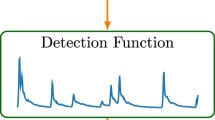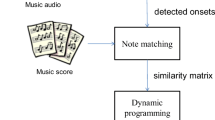Abstract
This paper develops a new method of onset detection for the Tar, a traditional Iranian musical instrument. The proposed method is based on both types of pitch and energy features. Therefore, it can be utilized to detect either soft or hard onsets. Through this combination, we obtained a more precise separation between two adjacent notes. This ability is especially useful to detect the reaz, repeatedly played notes with the same frequency and short durations. For the evaluation of the method, a data set with predetermined onsets was produced and the results were compared with an energy-based method explained in terms of F-measure.








Similar content being viewed by others
References
Argenti, F., Nesi, P., & Pantaleo, G. (2011). Automatic transcription of polyphonic music based on the constant-Q bispectral analysis. IEEE Trans. Audio, Speech Language Process, 19(6), 1610–1630.
Bello, J. P., Daudet, L., andC., S. A., Duxbury, M., Davies, & Sandler, M. (2005). A tutorial on onset detection in musical signals. IEEE Transactions on Speech and Audio Processing, 13(5), 1035–1047.
Bello, J. P., Duxbury, C., Davies, M., & Sandler, M. B. (2004). On the use of phase and energy for musical onset detection in the complex domain. IEEE Signal Processing Letters, 11(6), 553–556.
Bello, J. P., & Sandler, M. (2003). Phase-based note onset detection for music signals. In IEEE International Conference on Acoustics, Speech, and Signal Processing (IEEE Cat. No. 03TH8684), pp. 441–444.
Benetos, E., Dixon, S., Giannoulis, D., Kirchhoff, H., & Klapuri, A. (2013). Automatic music transcription: Challenges and future directions. Journal of Intelligent Information Systems, 41(3), 407–434.
Benetos, E., & Stylianou, Y. (2010). Auditory spectrum-based pitched instrument onset detection. IEEE Transactions on Audio, Speech, and Language Processing, 18(8), 1968–1977.
Bhalke, D. G., Rama Rao, C. B., & Borman, D. S. (2016). Automatic musical instrument classification using fractional fourier transform based- MFCC features and counter propagation neural network. Journal of Intelligent Information, 46(16), 445–446.
Böck, S., Arzt, A., Krebs, F., & Schedl, M., Online realtime onset detection with recurrent neural networks, In Proceedings of the 15th International Conference on Digital Audio Effects, pp. 15–18, 2012.
Bock, S., & Schedl, M. (2012). Polyphonic piano note transcription with recurrent neural networks, In ICASSP, IEEE International Conference on Acoustics, Speech, and Signal Processing, pp. 121–124.
Bock, S., & Widmer, G. (2013). Maximum filter vibrato suppression for onset detection, In Proceedings of the 16th International Conference on Digital Audio Effects, pp. 1–7.
Bouguelia, M. R., Nowaczyk, S., Santosh, K. C., & Verikas, A. (2017). Agreeing to disagree: Active learning with noisy labels without crowdsourcing. International Journal of Machine Learning and Cybernetics, 9(8), 1307–1319.
Brown, J. C. (1992). Musical fundamental frequency tracking using a pattern recognition method. Journal of the Acoustical Society of America, 92(3), 1394–1402
Brown, J. C., & Puckette, M. S. (1992). An efficient algorithm for the calculation of a constant Q transform. Journal of the Acoustical Society of America, 92(5), 2698–2701.
Collins, N. (2005). Using a pitch detector for onset detection. In International Symposium on Music Information Retrieval, pp. 100–106.
Collins, N. (2005). A comparison of sound onset detection algorithms with emphasis on psychoacoustically motivated detection functions. Audio Engineering Society Convention 118, 1, 34–45.
Degara, N., Davies, M. E. P., Pena, A., & Plumbley, M. D. (2011). Onset event decoding exploiting the rhythmic structure of polyphonic music. IEEE Journal of Selected Topics in Signal Processing, 5(6), 1228–1239.
Dixon, S. (2006). Onset detection revisited. In Proceedings of the 9th International Conference on Digital Audio Effects, pp. 1–6.
Duxbury, C., Sandler, M., & Davies, M. (2002). A hybrid approach to musical note onset detection. In 5th International Conference on Digital Audio Effects (DAFx-02), Hamburg, Germany, pp. 33–38.
Gainza, M., & Coyle, E. (2011). Tempo detection using a hybrid multiband approach. IEEE Transactions on Audio, Speech, and Language Processing, 19(1), 57–68.
Heo, H., Sung, D., Lee, K. (2013). Note onset detection based on harmonic cepstrum regularity. In IEEE International Conference on Multimedia and Expo (ICME), San Jose, CA, USA, pp. 1–6,.
Heydarisan, P. (2016). Automatic recognition of Persian musical models in audio musical signals. Doctoral thesis, London Metropolitan University.
Klapuri, A. (1999). Sound onset detection by applying psychoacoustic knowledge. In IEEE International Conference on Acoustics, Speech, and Signal Processing. ICASS P99 (Cat. No.99CH36258), Vol. 6, pp. 3089–3092.
Liang, C., Su, L., & Yang, Y. (2015). Musical onset detection using constrained linear reconstruction. IEEE Signal Processing Letters, 22(11), 2142–2146.
Marchi, E., Ferroni, G., Eyben, F., & Squartini, S. (2014). Audio onset detection: A wavelet packet based approach with recurrent neural networks. In International Joint Conference on Neural Networks (IJCNN), Beijing, China.
Masri, P. (1996). Computer modelling of sound for transformation and synthesis of musical signals. (Doctoral dissertation, University of Bristol).
Oliveira, J. L., Davies, M. E. P., Gouyon, F., & Reis, L. P. (2012). Beat tracking for multiple applications: A multi-agent system architecture with state recovery. IEEE Transactions on Audio, Speech, Language Processing, 20(10), 2696–2706.
Percival, G., & Tzanetakis, G. (2014). Streamlined tempo estimation based on autocorrelation and cross-correlation with pulses. IEEE/ACM Transactions on Speech and Language Processing, 22(12), 1765–1776.
Reis, G., Fernandéz, F., De Vega, & Ferreira, A. (2012). Automatic transcription of polyphonic piano music using genetic algorithms, adaptive spectral envelope modeling, and dynamic noise level estimation. IEEE Transactions on Speech and Language Processing, 20(8), 2313–2328.
Robinson, D. W., & Dadson, R. S. (1956). A re-determination of the equal-loudness relations for pure tones. British Journal of Applied Physics, 7(5), 166–181.
Santosh, K., Hangarge, M., Bevilacqua, V., & Negi, A. (2017). A Fast k-Nearest Neighbor Classifier Using Unsupervised Clustering. In: Recent Trends in Image Processing and Pattern Recognition. RTIP2R 2016, Communications in Computer and Information Science, Vol. 709. Singapore: Springer.
Schloss, A. W. (1985). On the Automatic Transcription of Percussive Music - From Acoustic Signal to High-Level Analysis. Doctoral thesis. Stanford University.
Sephus, N. H., Lanterman, A. D., & Anderson, D. V. (2014). Modulation spectral features: In pursuit of invariant representations of music with application to unsupervised source identification. Journal of New Music Research, 44(1), 58–70.
Sigtia, S., Benetos, E., & Dixon, S. (2016). An end-to-end neural network for polyphonic piano music transcription. IEEE/ACM Transactions on Audio, Speech and Language Processing, 24(5), 927–939.
Stasiak, B., Mońko, J., & Niewiadomski, A. (2016). Note onset detection in musical signals via neural-network-based multi-ODF fusion. International Journal of Applied Mathematics and Computer Science, 26(1), 203–213.
Stylianou, Y., & Gedik, A. C. (2010). Three dimensions of pitched instrument onset detection. IEEE Transactions on Audio, Speech and Language Processing, 18(6), 1517–1527.
Thoshkahna, B., & Ramakrishnan, K. R. (2008). A psychoacoustics based sound onset detection algorithm for polyphonic audio music and audio. In 9th International Conference on Signal Processing (ICSP), pp. 1424–1427.
Tian, M., Black, D. A. A., & Sandler, M. (2014). Design and evaluation of onset detectors using different fusion policies. In 15th International Society for Music Information Retrieval Conference (ISMIR 2014) Design, Ismir, pp. 631–636.
Todisco, M., Delgado, H., & Evans, N. (2016). A new feature for automatic speaker verification anti-spoofing: constant Q cepstral coefficients. In Speaker Odyssey Workshop, Bilbao, Spain.
Todisco, M., Delgado, H., & Evans, N. (2017). Constan Q cepstral coefficients: A spoofing countermeasure for automatic speacker verification. Computer Speech & Language, 45, 516–535.
Zhou, R., Mattavelli, M., & Zoia, G. (2008). Music onset detection based on resonator time frequency image. IEEE Transactions on Audio, Speech and Language Processing, 16(8), 1685–1695.
Zhou, R., & Reiss, J. D. (2007). Music onset detection combining energy-based and pitch-based approaches. In Proceedings MIREX Audio Onset Detection Contest.
Author information
Authors and Affiliations
Corresponding author
Rights and permissions
About this article
Cite this article
Farrokhi, B., Kabir, E. & Sajedi, H. Onset detection for tar solo. Int J Speech Technol 21, 761–771 (2018). https://doi.org/10.1007/s10772-018-9534-5
Received:
Accepted:
Published:
Issue Date:
DOI: https://doi.org/10.1007/s10772-018-9534-5




